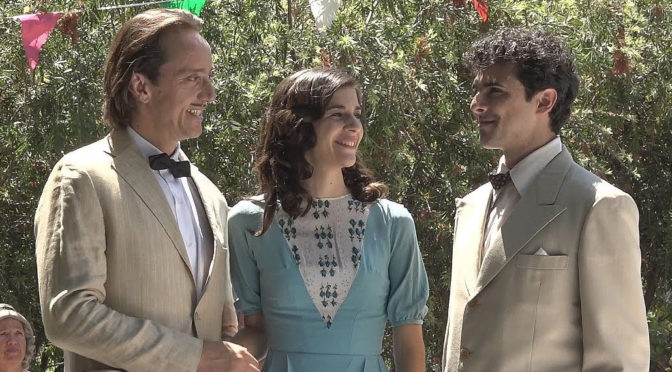Towards the end of her life, Anna Maria Dalí ruminates on her relationship with her brother, the painter Salvador, from their beginnings in the northern Catalan city of Figueres, through his often scandalous career, to his sad decline and death in 1989.
This is a curious enterprise, which retains most of the faults of a standard biopic — breadth instead of depth, famous events replayed as lifeless tableaux, endless name-dropping — and adds some extra of its own, in the guise of a ‘present-day’ (actually 1989) two-hander between Anna Maria and her old friend from Cambridge University. This part of the film — in effect, an animated scrapbook — is conducted in English by those two great British veterans Sian Phillips (as Anna Maria) and Claire Bloom. Though doomed to fail, they do what they can with a script that seems almost like a guide on how not to do exposition.
At heart, the film seeks to claim Dalí as a true son of Catalonia, whether the old provocateur would have approved or not. He is shown to be a precociously gifted and spoiled offspring of a solidly bourgeois (if Republican-leaning) Catalan family, who always referred to him as ‘the boy’. Though increasingly critical of his actions, the film never questions Dalí’s own, very high estimation of his genius, with the result that his friend, collaborator and later enemy Buñuel is given short shrift. His depiction as a bad-tempered, not necessarily talented boor is unlikely to endear the film to his admirers. (Even Buñuel’s idea for the eye-opening sequence that begins their collaboration UN CHIEN ANDALOU is credited to Dalí.) The poet and playwright Lorca, by contrast, is shown to be an almost angelic presence, affectionately courtly towards Anna Maria and absolutely infatuated with Dalí himself.
Unforgivably long at almost three hours, the film also gives some evidence of having been made on the cheap. On the other hand, its makers did go to the trouble of giving it a busily emotive orchestral soundtrack — although, in the end, this comes across as just another indicator of a not very imaginative biopic.


This review not only assumes, without seeming to stop to ask itself what a bio-pic is, that Miss Dalí (2018) is one, and also that it is one of Salvador Dalí : contrary to the title, the opening sentence of the review, and such facts as our never being shown a single mature work by Salvador Dalí.
There are dozens of books about him, but one need only read what Ian Gibson’s early biography, The Shameful Life of Salvador Dalí, says about Luis Buñuel’s and his collaborations on Un chien andalou (1929) and L’âge d’or (1930) to know that Buñuel contradicts himself on questions of attribution. When talking about the former film, Gibson reports that ‘In 1929, shortly after the film was made, Buñuel told Georges Bataille that it had been Dalí’s idea’.
Perhaps someone has settled that one in Buñuel’s favour, since Gibson published in 1997, but one is still left with the fact that the scene with the two men, who are alone, is presented as what Ana María Dalí believed happened. Maybe the writer / director, Ventura Pons, should be credited with having sufficiently researched what he says she believed ?